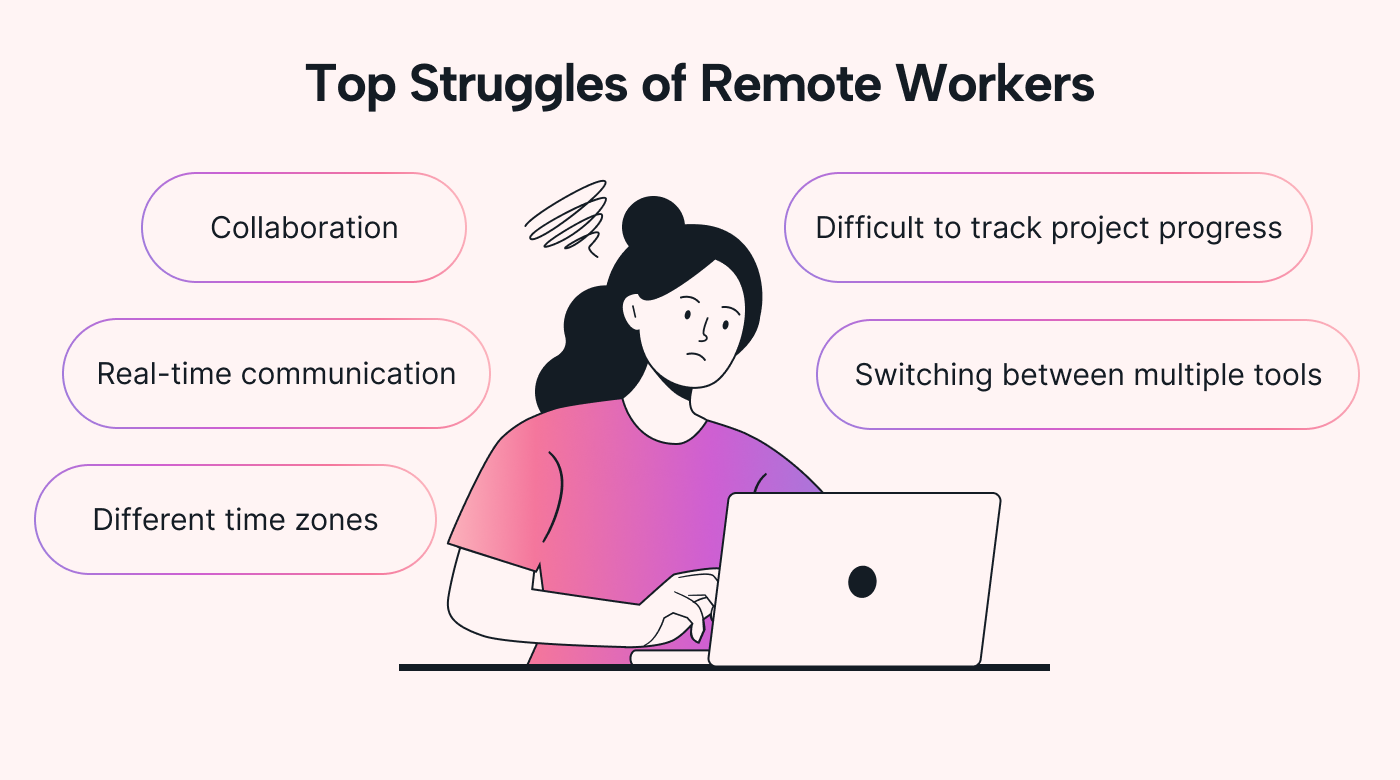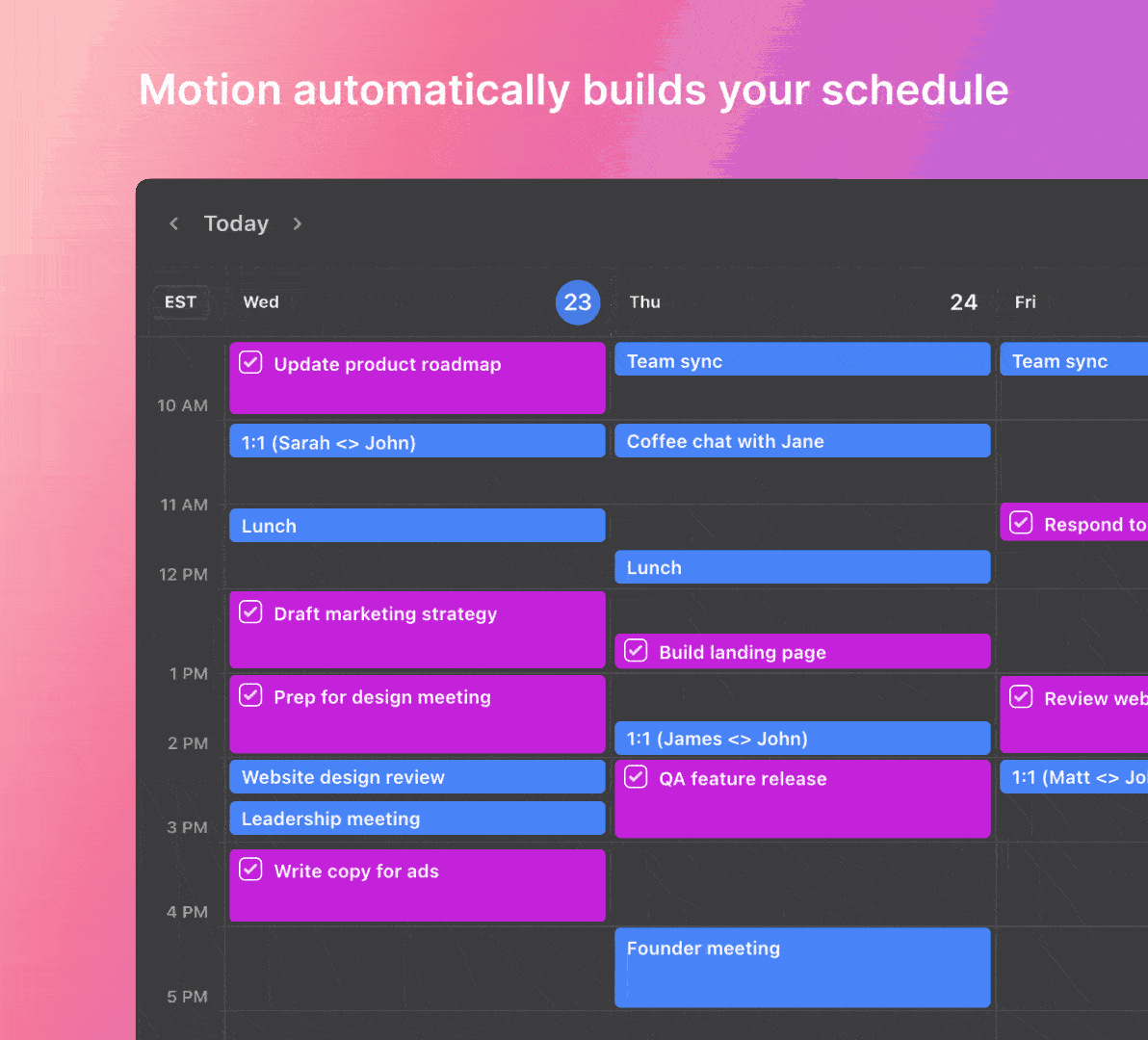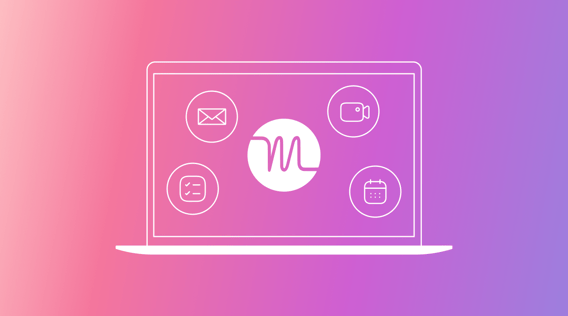The prevalence of remote work has increased significantly over the past few years. In fact, as of 2023, 40% of US employees are working remotely at least one day a week.
Managers must keep up with the latest technologies to efficiently manage and support a remote or hybrid team.
With location no longer a limiting factor, the need for effective tools to bridge the gaps between distant team members becomes more important than ever. In this article, we list nine must-have tools to help your team stay ahead in the digital workspace.
Why does your team need remote work tools?
The way we work is rapidly changing. No longer are employees nestled into cubicles or open workspaces at the office. The modern workforce now relies on remote working tools to communicate, collaborate, and get work done.
These technologies address the top struggles that remote workers face, like time zone differences, challenges tracking project progress, and collaboration obstacles.
 |
Ultimately, you’ll need remote work apps to help with the following:
To make scheduling easy for everyone
As of 2023, 62% of people work directly with teammates in different time zones.
While being on a distributed team has its perks, the challenges of navigating different time zones and availability can’t be ignored. Missed calls or compromised sleep, for instance, can disrupt a team’s workflow.
Fortunately, the right remote tools, such as synchronized calendars, can help you mitigate time-related conflicts and make scheduling online meetings easier. As a result, teams can improve their productivity and enhance their collaboration abilities.
To better communicate and connect online
Clear communication is crucial to not only getting messages across but also minimizing miscommunication, which often happens in lengthy email threads. Seventy-two percent of business leaders agree that effective communication has increased their team’s productivity.
 |
Many types of remote work software are designed to improve and refine online interactions, not only mimicking in-person conversations but also bringing more clarity to virtual ones. With these tools, team members can communicate more effectively, staying engaged and informed as a result.
To keep track of projects
Staying aligned is one of the keys to maintaining a high-functioning team. Ninety-four percent of workers believe knowing what their team members are working on improves their own efficiency and productivity.
This is even more crucial for remote and hybrid teams — where physical distance can lead to informational gaps. Remote working tools give these teams more visibility and clarity. Teams can track projects and each other’s progress in real time to ensure tasks are on track and, ultimately, completed on time.
To ensure easy and safe file sharing
How much time do you spend looking for files and documents? According to 54% of office workers, they find themselves spending more time conducting document searches than communicating with clients.
This statistic suggests the need for dependable and secure file-sharing systems in the workforce.
Many remote tools offer a centralized platform to store and share documents, a function that significantly reduces the time it takes to find what you need and allows remote teams to access and work together on files in one place.
9 remote work tools every distributed team needs
With remote work becoming more common, a wide selection of remote working software is available on the market. Here, we spotlight the top nine remote work tools that every team should have in their arsenal:
An all-in-one remote work tool
Get everything you need with an all-in-one remote working tool. This software is indispensable for remote employees because it centralizes diverse functions, eliminating the need to juggle between multiple collaboration tools and platforms.
1. Motion
Motion tackles the majority of remote work challenges in one unified platform. Acting as your personal meeting assistant, Motion allows you to share your availability, change your meeting preferences, and schedule meetings effortlessly.
This means no more back-and-forth emails trying to find a suitable time. Instead, simply click and schedule the ideal date for everyone involved. Motion’s intelligent calendar then automatically builds the meeting into your daily schedule.
 |
At the same time, Motion is a project and task manager. With it, teams can not only track the progress of their projects but also monitor how individual team members are progressing. This cuts through the uncertainty often associated with remote work and aligns the team as they continue with the project.
On top of that, Motion automatically prioritizes and delegates the most important tasks to the appropriate team members.
Motion’s direct communication channel also allows teams to communicate and comment on projects, strengthening the feedback loop and clarifying team communication.
Motion simplifies the complexities of remote work, improving operational workflows and team collaboration. It’s an all-in-one tool that makes sure your remote teams remain connected and productive.
Key features:
- AI-powered calendar and project manager
- Effortless meeting scheduler
- Real-time progress tracking
- Centralized storage for projects
- Integration with a wide range of apps through Zapier
Remote scheduling tools
With their members scattered across time zones, remote teams especially need tools to help with meeting coordination. Remote scheduling tools provide shared calendars, time zone conversions, and easy booking to simplify the scheduling process.
2. Calendly
Calendly offers a new way to schedule: smart scheduling, which streamlines appointment scheduling for remote teams. Teams and clients can select meeting times and book meetings instantly through an accessible link.
Calendly also integrates with widely used calendars, preventing appointments from overlapping. Furthermore, you can customize a range of features, such as setting buffer times or creating distinct event types. With Calendly, you can support your remote employees with consistent and organized scheduling.
Key features:
- One-click meeting links
- Customizable settings
- Real-time scheduling and availability
3. HubSpot Meetings
HubSpot Meetings integrates scheduling with the power of a CRM. It not only allows you to set up meetings but also inputs important contact details into the HubSpot contact database. This way, you can automatically grow and organize your database.
You and your team or clients can use a shared link to view available times and book a slot without any need for back-and-forth emails. Hubspot Meetings also offers integration with Google and Office 365 Calendars to avoid double-booking mishaps.
Key features:
- Automated email reminders to reduce no-shows
- Customize meeting links to match branding
- Blended scheduling and sales
Remote communication tools
Clear communication bridges the distance between remote employees. Instant messaging platforms ensure teams can collaborate effectively, discuss projects in real time, and maintain a shared vision. They’re a substitute for in-person office chats and help ensure messages get across clearly.
4. Slack
Slack is a communication hub for remote teams. It organizes conversations into channels so teams can keep discussions project-specific. This helps reduce the likelihood of off-topic diversions.
With Slack, you also have the option of private instant messaging for one-on-one or limited group discussions when confidentiality is needed. All past conversations are saved and can be found quickly with the software’s search function.
Slack also integrates with third-party apps, like Google Drive and Trello, to centralize tools and information.
Key features:
- Channel-based communication
- Retrieve past chats quickly
- Option for in-app video calls and voice calls
5. Zoom
Since the start of the COVID-19 pandemic, Zoom has emerged as the go-to communication tool for teams wanting to stay connected. It’s essentially a virtual meeting room. Whether it’s being used for official team meetings, interactive webinars, or spur-of-the-moment brainstorming sessions, Zoom makes real-time communication from afar possible.
Zoom offers high-quality video and audio and a simple interface that’s easy to use for even the least tech-savvy team members. There’s also a screen-sharing function — perfect for online presentations and demonstrations.
Moreover, Zoom’s online whiteboard allows teams to sketch ideas, annotate documents, and brainstorm in a digital space.
Key features:
- Virtual backgrounds for personalization or privacy
- Breakout rooms for focused discussions
- Touch-up appearance function adjusts lighting and smoothens skin
Remote project management tools
Project management tools, or task management tools, are a lifeline for remote workforces. They help teams manage, organize, and track project developments from one place. They also enable everyone to review team members’ roles and responsibilities, helping to keep projects on track and ensuring their timely delivery.
6. Trello
Trello stands out with its visual-centric approach to remote project management. Teams can use boards, lists, and cards to easily organize tasks and monitor their projects’ progress. Each card serves as a detailed task note, complete with descriptions, checklists, deadlines, and attachments. This clarity allows the entire team to see each other’s tasks, assignments, and any approaching deadlines.
An additional advantage is Trello’s ability to break down complex tasks into smaller, manageable steps through its checklist feature. Moreover, the platform provides productivity metrics that offer insights into team performance and help identify areas for improvement.
Key features:
- Customizable labels and tags
- Built-in automation
- Drag-and-drop function that allows the rearrangement of tasks and priorities
7. Wrike
Wrike is a dynamic task management tool that seamlessly integrates tasks, schedules, and discussions. Projects can be broken down into tasks and subtasks, and each of these can be assigned to specific team members.
Remote employees benefit from Wrike’s timeline views and Gantt charts, which offer a clear visual representation of project timelines, dependencies, and critical paths. This allows for effective planning and adjustments.
Wrike’s customizable dashboards let teams design their digital workspace to their preference so that everyone can quickly access what they need.
Not only that, but Wrike’s real-time activity stream helps ensure that all team members are kept in the loop about project changes or updates.
Key features:
- Customizable dashboards for tailored views
- Real-time activity stream for instant updates
- Integrations with popular tools
Remote file-sharing and cloud storage tools
Paper trails have largely been replaced by electronic files. Yet, without the right systems in place, locating the file you need can feel like searching for a needle in a haystack. For remote teams especially, consistent and easy access to shared resources is essential.
File sharing and cloud storage platforms provide a centralized space to store all documents so that your team members can find up-to-date information regardless of their location.
8. Google Drive
Operating in the cloud, Google Drive is like a secure online storage room where you can keep various files, documents, and images. You can securely share files with any team members you want.
Google Drive also has real-time collaboration capabilities. Multiple team members can simultaneously work on the same document, with changes being saved constantly.
Moreover, Google Drive has a robust search function, making it easy to find files even if you’re not sure where you initially saved them.
Google Drive integrates with other Google services, such as Google Docs, Google Sheets, and Google Slides. This means you can create and edit documents directly on the drive.
Key features:
- Real-time collaboration on document editing
- Robust search function
- Integration with other Google services
9. Dropbox
Dropbox is a cloud-based file storage and sharing platform. With it, you can upload and store important documents and multimedia files.
Remote teams can access Dropbox files from virtually anywhere using any device with an internet connection. This feature ensures that all team members have the resources they need right at their fingertips.
In addition to its core storage features, Dropbox offers a line of products that integrate with its platform. These include the ability to quickly and securely deliver large files and sign legally binding eSignatures.
Key features:
- Smart sync, which saves room on your hard drive
- Revision tracking for file history
- Ability to collect files from non-Dropbox users
How Motion helps remote teams work smarter
Why switch between multiple tools when you can have everything you need in one? Meet Motion, the ultimate remote work tool that’s here to make life easier for your remote team.
From meeting scheduling and project management to communication and storage, we’ve got your back. Motion provides a unified platform that facilitates better collaboration and supercharges your team’s productivity and efficiency.
Our meeting assistant simplifies the process of scheduling remote meetings. All you need to do is set your meeting preferences and availability while Motion handles the scheduling. Motion’s intelligent calendar seamlessly integrates meetings into your day and optimizes your schedule.
Our project management software empowers your team to track project progress and monitor individual contributions. Motion also automatically prioritizes and delegates essential tasks to the right team members for optimal workflow. Moreover, its direct communication channels allow your team to interact and provide feedback efficiently.
And the best thing? All of that comes in one single platform. Work smarter, not harder, with Motion.
What teams are saying about Motion
Don’t just listen to what we have to say. Clients from many different sectors have experienced Motion’s magic.
Here’s what our clients are saying:
 |
 |
Experience Motion for yourself
Make the switch to Motion today, and discover a new era of remote work where everything you need is right at your fingertips. Try Motion for free now.





